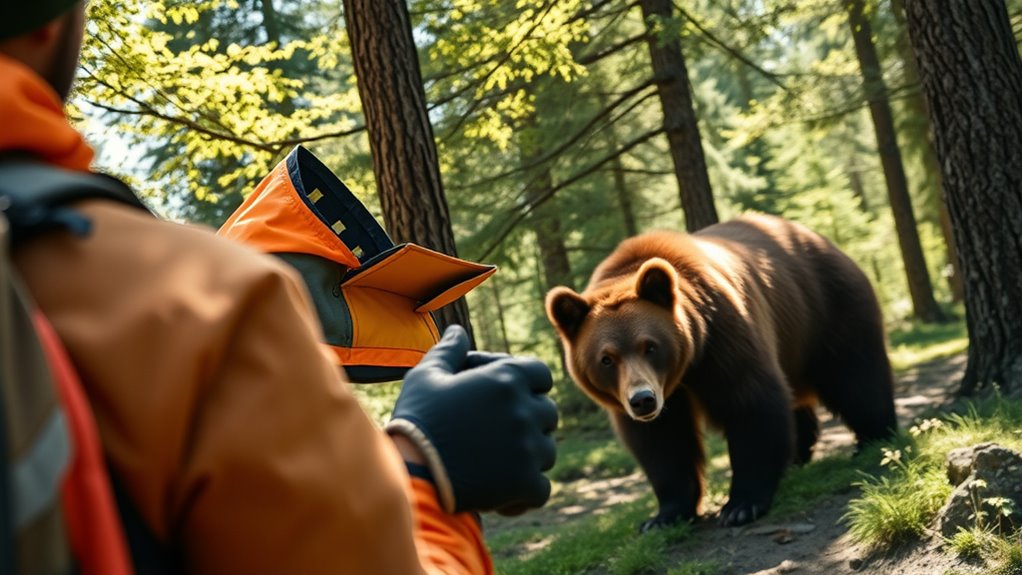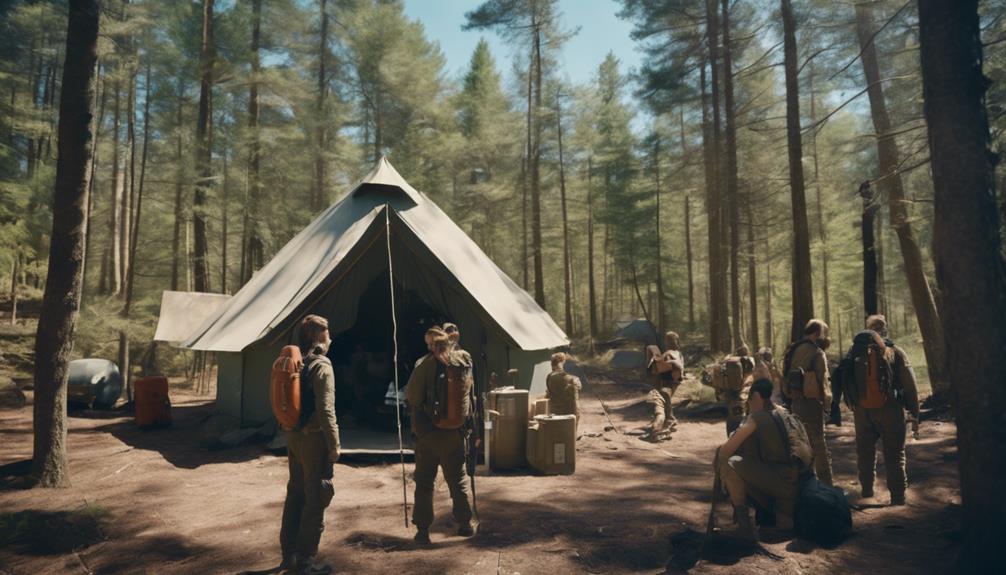When dealing with wild animals, stay calm, avoid quick movements, and give them plenty of space. Recognize signs of aggression like raised hackles, snorting, or aggressive posturing, and back away slowly if you see them. Properly store food away from wildlife and keep camps at safe distances. Using deterrents like noise or bear spray can help. Learning these key safety tips guarantees you’re better prepared—continue to explore how to stay safe in wild habitats.
Key Takeaways
- Recognize warning signals like snorting, tail flicking, or aggressive postures to identify potential threats early.
- Maintain safe distances—at least 25 yards from large herbivores and 50 yards from moose or elk.
- Stay calm, avoid sudden movements, and slowly back away if animals show signs of agitation or approach.
- Use deterrents such as loud noises, waving clothing, or bear spray to discourage aggressive wildlife encounters.
- Store food securely and keep campsites at least 200 yards from animal habitats to prevent attracting wildlife.
Recognizing Wildlife Body Language and Signs of Aggression

Understanding wildlife body language is essential for safe encounters, as animals often give clear signals when they feel threatened or aggressive. Recognizing aggression signs in wildlife allows you to gauge their mood and respond appropriately. For example, bears may snort, paw the ground, or stand on their hind legs to show agitation. Mountain lions tend to crouch low, flick their tails, or fix their gaze, indicating potential attack. Snakes rattle, flatten their heads, or hiss as warning signs. Bovine animals like bison or elk might charge if they pin back their ears, stomp, or lower their heads with horns pointed forward. Paying close attention to these body language cues helps you recognize danger early, ensuring your safety and avoiding dangerous encounters with wildlife. Being aware of safe handling techniques can further reduce risks during close encounters. Additionally, understanding species-specific behaviors enhances your ability to interpret animal signals accurately. Recognizing the importance of veterinary care and habitat preservation can also contribute to safer human-wildlife interactions by supporting healthy animal populations. Being knowledgeable about wildlife stress signals can help prevent escalation during encounters. Cultivating awareness of local wildlife populations and their habits can improve your overall safety and preparedness.
Proper Food Storage and Camp Setup to Prevent Encounters

Proper food storage and camp setup play an essential role in preventing wildlife encounters. To avoid attracting animals, store all food, scented items, and trash securely using bear canisters, coolers, or by hanging them at least 10 feet off the ground and 4 feet from a tree trunk. Set up your campsite at least 200 yards from animal habitats and water sources to reduce the chance of wildlife encounters. Keep cooking and washing dishes at least 100 yards away from your sleeping area to prevent scent trails that lure animals. Use food hang systems, like pulley or bear bag techniques, to keep food and trash out of wildlife reach overnight. Incorporating proper food storage methods can significantly reduce the likelihood of attracting animals to your campsite. Regularly inspecting and maintaining your wildlife deterrent devices ensures they remain effective in preventing unwanted visits. Following these safety tips helps protect both you and the animals, minimizing risky encounters. Incorporating modern toilet fixtures in your campsite setup can also improve sanitation and reduce odors that might attract animals.
How to Respond When Approaching or Encountering Bears
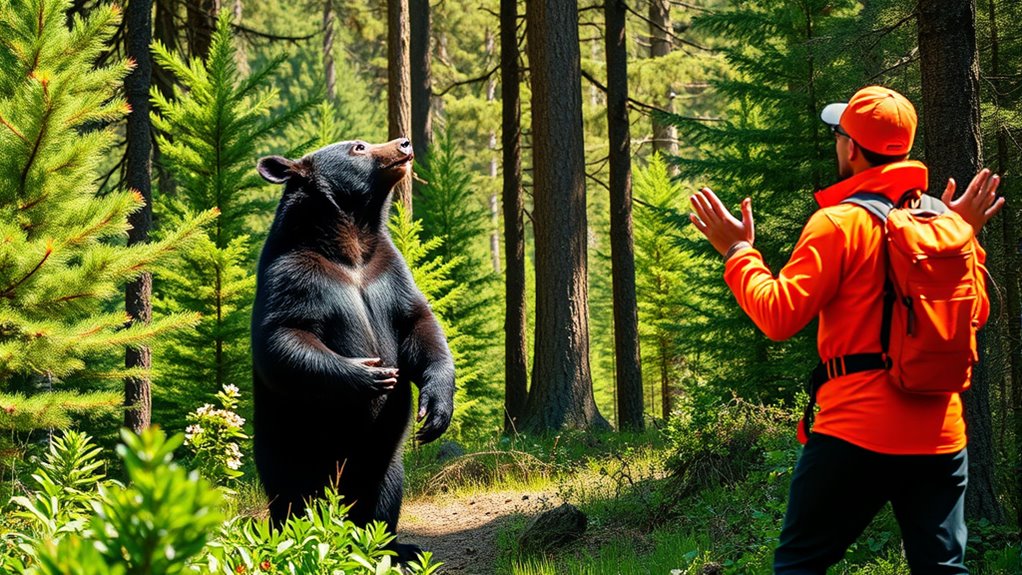
When you encounter a bear in the wild, staying calm and avoiding sudden movements are essential to preventing escalation. Keep your eyes on the bear without staring aggressively, and slowly back away—never run or turn your back. Making noise, such as shouting or waving your arms, can help alert the bear of your presence and deter it from approaching further. If the bear approaches aggressively, use bear spray by aiming it at the face from about 30 feet away. To appear larger and more intimidating, raise your arms or wave clothing. Remember, in wildlife safety, your goal is to avoid startling the bear or provoking an attack. Staying aware of animal behaviors and giving the bear plenty of space to leave peacefully can significantly improve your safety during encounters. Utilizing proper safety gear, like bear spray and awareness of animal behaviors, can significantly enhance your safety during encounters. Recognizing wildlife interactions and respecting their space are key components of outdoor safety. Being familiar with local wildlife regulations can also help you understand how to respond appropriately in various situations. Additionally, understanding the typical behavior patterns of bears can help you anticipate their actions and react accordingly.
Safety Procedures for Mountain Lion and Cougar Encounters

If you encounter a mountain lion or cougar in the wild, staying calm and acting confidently can make a big difference. Keep your eyes on the animal and avoid turning your back. Make yourself larger by waving your arms or holding objects to intimidate the mountain lion. Slowly back away without rushing, maintaining eye contact and speaking loudly to alert the animal of your presence. Never run or crouch down, as sudden movements can trigger an attack. If the mountain lion attacks, fight back aggressively using nearby objects like sticks or rocks, aiming for its face and eyes. After the encounter, report it to park authorities immediately. Staying calm, making yourself larger, and knowing how to respond can help keep you safe during a mountain lion encounter. Additionally, understanding AI safety measures and being aware of potential risks can help in planning safer outdoor activities. Always stay updated on wildlife behavior to better anticipate and respond to animal encounters. Being aware of security zone information can also help you recognize safe areas and avoid dangerous wildlife hotspots.
Guidelines for Avoiding and Managing Bison and Large Herbivore Interactions

To stay safe around bison and large herbivores, maintaining a minimum distance of 25 yards is essential. Wild animals like bison can become aggressive if they feel threatened, so avoid provoking them. Never chase or approach bison or other large herbivores, as they can run up to 40 mph and may charge if disturbed. Watch for signs of agitation, such as pawing, snorting, or head tossing; if you see these, back away slowly to prevent escalation. Keep a safe distance from elk calves and avoid touching or moving them to prevent triggering maternal defense. If large herbivores approach, use loud noises, wave clothing, or throw rocks to deter them and give animals space to leave peacefully. Remember that understanding their natural behavior and habitat conservation efforts can help you stay safe while respecting wildlife. Additionally, being aware of animal behavior signals can help you recognize when an animal is agitated and needs space.
Actions to Take When Encountering Snakes and Reptiles
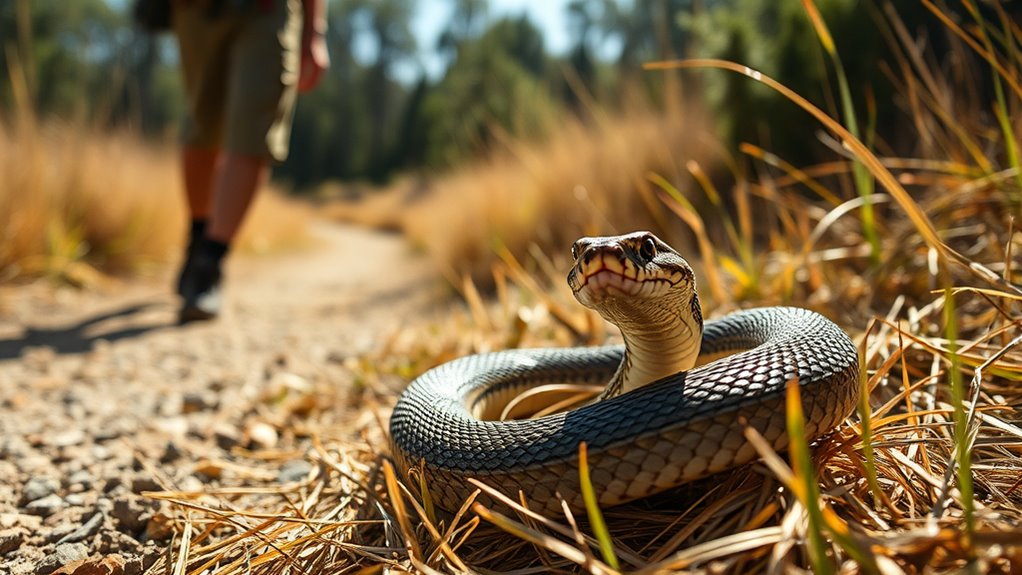
Coming across snakes and reptiles in the wild requires calm and deliberate actions. If you see a snake, stay calm and avoid panicking. Slowly back away to give the snake space without making sudden movements. Do not stick your hands or feet into logs, rocks, or tall grass, as snakes may be hidden there. Be especially cautious when stepping over logs or rocks, particularly in areas known for rattlesnakes, copperheads, or cottonmouths. Use a flashlight at night or in low light to spot snakes around trails or campsites. If bitten, seek medical attention immediately and try to remember the snake’s appearance for identification. Staying calm and cautious can prevent bites and ensure your safety in snake-prone areas. Being aware of wildlife activity can help you recognize signs of animal presence and stay safe during your outdoor adventures. Recognizing snake habitats can also increase your awareness and help you avoid dangerous encounters. Additionally, understanding snake behavior can aid in predicting their movements and reducing the risk of accidental encounters. Developing an understanding of animal communication can further enhance your ability to interpret animal signals and stay safe.
Strategies for Protecting Yourself During Moose and Elk Encounters
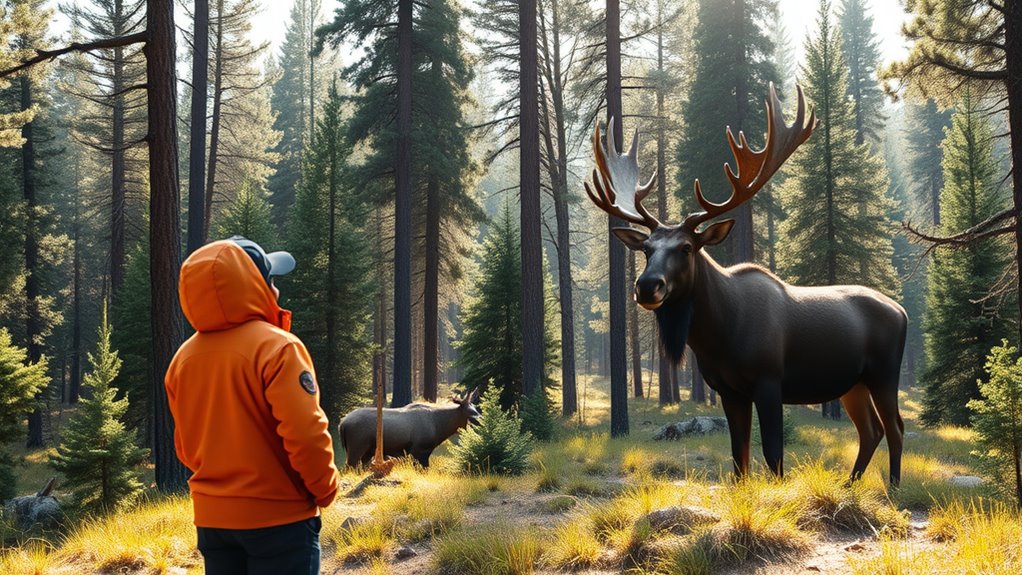
When you encounter moose or elk in the wild, maintaining a safe distance is essential to prevent aggressive behavior. Stay at least 50 yards away from these animals to reduce the risk of confrontation. If a moose approaches or shows signs of agitation—such as laid-back ears or raised hair—back away slowly and speak softly to avoid provoking it further. If a moose or elk charges, find protection behind a sturdy object and remain alert. Do not try to touch or feed elk calves, as this can trigger an aggressive response. For elk, using loud noises or waving clothing can help deter an approaching or charging animal. Prioritizing safety and respecting their space is key to avoiding dangerous encounters with moose and elk.
Tips for Dealing With Aggressive Mountain Goats and Other Small Wildlife
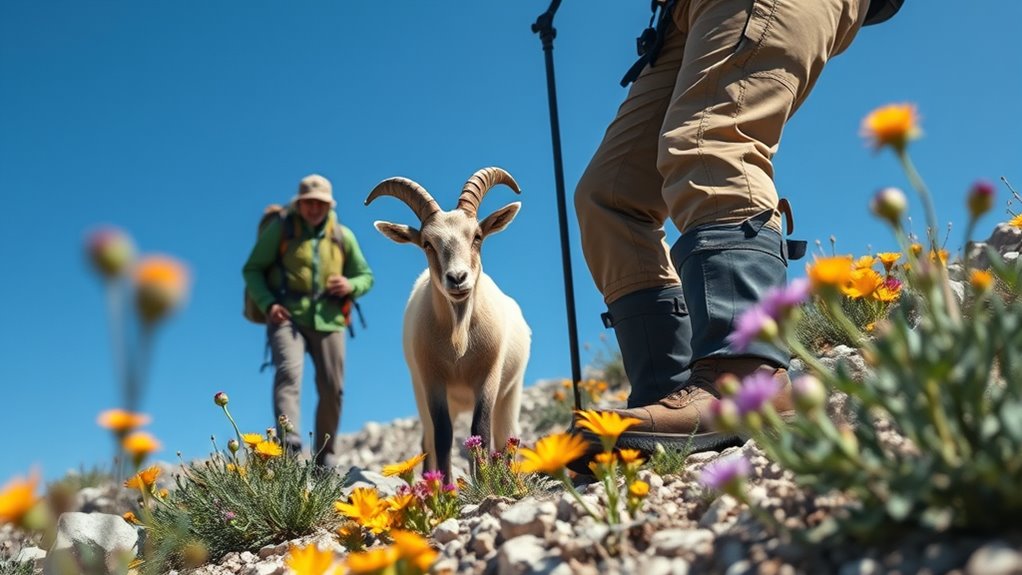
While avoiding large mammals like moose and elk is important, smaller wildlife such as mountain goats can also pose risks if they feel threatened. Keep at least 50 yards away from mountain goats, as they can become aggressive if approached too closely. Watch for warning signs like raised hair, head-butting, or aggressive posturing, which indicate the animal may charge. If you encounter an aggressive mountain goat, do not try to touch or corner it. Instead, stand your ground, make yourself appear larger, and use loud noises, waving clothing, or throwing rocks to scare it off. If a mountain goat charges, back away slowly while shouting and avoid contact with its sharp horns, which can cause injury. Staying alert and cautious helps prevent dangerous encounters with wildlife.
Essential Equipment and Preparedness for Wildlife Encounters
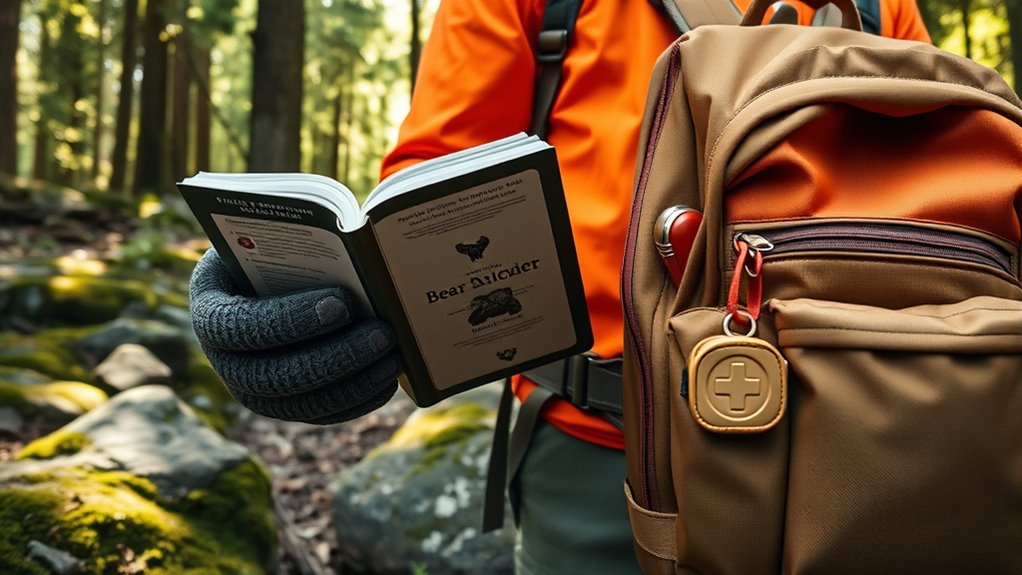
Being prepared with the right equipment is vital for safely managing wildlife encounters. Carrying wildlife safety gear such as bear spray, whistles, and flashlights guarantees you’re ready for unexpected animals. Knowing how to properly use bear spray, effective within 30 feet, can deter aggressive wildlife during an encounter. Proper food storage is indispensable; use bear canisters, hang food in trees, or employ coolers to prevent attracting animals. Familiarize yourself with setting up secure food hangs and bear-proof containers through instructional resources. Carrying these items and understanding their use enhances your preparedness and response during wildlife encounters. Remember, being equipped with the right gear and knowledge minimizes risks and keeps both you and the animals safe.
Frequently Asked Questions
What Are 3 Safety Precautions Do You Take Around Animals?
When you encounter wild animals, you should keep a safe distance of at least 75 to 120 feet to avoid provoking them. Make yourself look bigger by raising your arms or waving clothing, then slowly back away. Use loud noises like talking or shouting to alert them of your presence, and carry bear spray or deterrents for added safety. Remember, never feed, pet, or approach wild animals, especially mothers with young.
What Can We Do to Keep Wild Animals Safe?
You might think wild animals are dangerous, but you can help keep them safe too. By keeping habitats undisturbed, disposing of waste properly, and avoiding feeding animals, you prevent habituation and stress. Use loud noises to alert animals of your presence, maintain safe distances, and store food securely. Educate yourself on animal behavior to recognize signs of stress, ensuring both your safety and theirs. Your actions make a difference in wildlife conservation.
How to Defend Yourself Against Wild Animals?
When you encounter a wild animal, stay calm and act confidently. Carry bear spray and aim it at the animal’s eyes and nose from about 30 feet away. Make yourself appear larger by raising your arms, and speak loudly to scare it off. Back away slowly, avoiding sudden movements. If attacked, fight back with sticks, rocks, or available objects to defend yourself effectively.
How to Handle a Wild Animal?
Imagine you’re in a quiet forest, suddenly face-to-face with a wild animal. To handle this, stay calm and avoid sudden moves. Make yourself look bigger by raising your arms or standing on tiptoes, then slowly back away without turning your back. Use loud noises like shouting or clapping to scare it off. Keep at least 75 feet away, never touch or feed it, and carry deterrents like bear spray for safety.
Conclusion
By understanding wildlife behavior and staying prepared, you can navigate nature’s playground safely. Think of it as dancing with wild animals—respect and awareness keep you in harmony. Always recognize signs of aggression, store food securely, and know how to respond if you encounter a bear, mountain lion, or other animals. With these tips, you’ll turn wild encounters from potential chaos into opportunities for safe adventure and respect for the wilderness.

